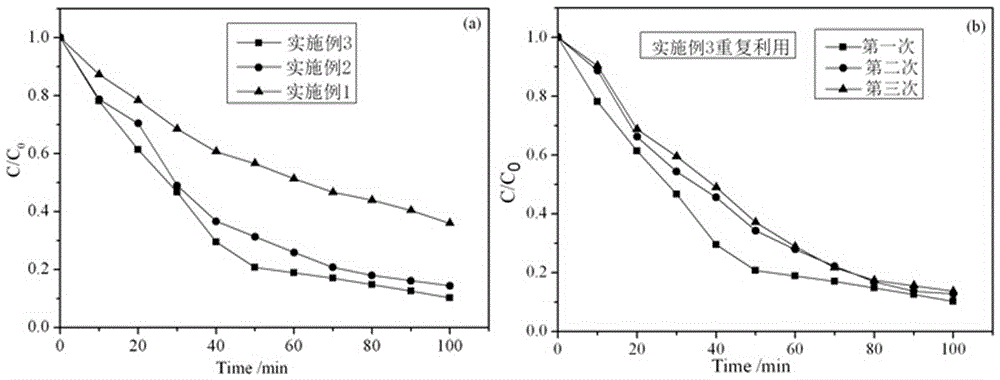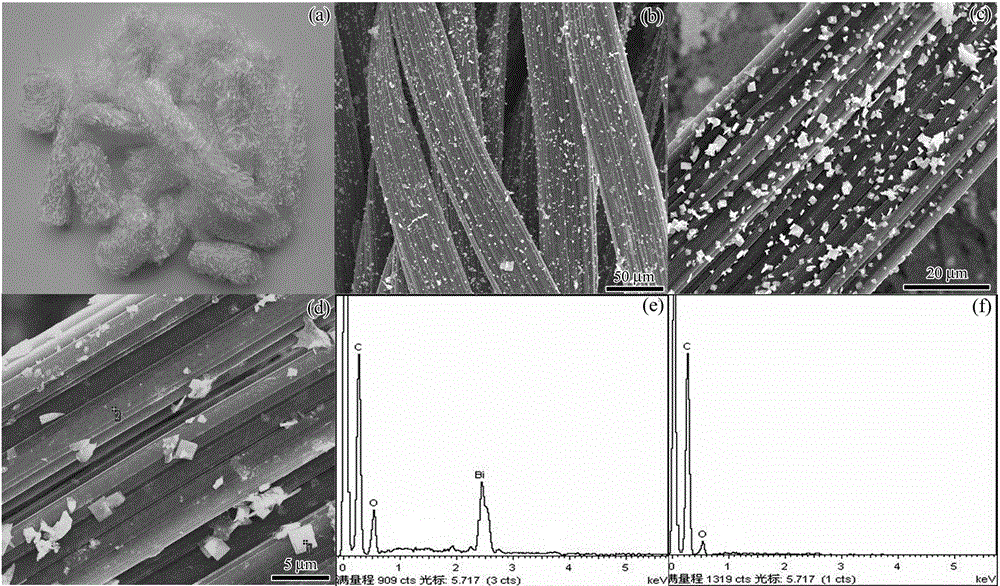Composite (BiO)2CO3/C photocatalyst and application thereof
A catalyst, composite light technology, applied in physical/chemical process catalysts, chemical instruments and methods, chemical/physical processes, etc., to achieve the effects of large specific surface area, good hygroscopicity and permeability, good recovery and secondary utilization
- Summary
- Abstract
- Description
- Claims
- Application Information
AI Technical Summary
Problems solved by technology
Method used
Image
Examples
Embodiment 1
[0028] Cut the bamboo fiber into 2cm-long segments, and boil the bamboo fiber in boiling water at 100°C for 30 minutes. The purpose of boiling is to clean the surface of the bamboo fiber so that it will not stick during the subsequent high-temperature carbonization process. After boiling, the bamboo fibers are dried at a temperature of 80°C for 6 hours. Soak the treated bamboo fiber in 0.1mol / L bismuth nitrate solution, the mass ratio of bamboo fiber to bismuth nitrate is 1:15, and the soaking time is 4h. Calcined in a muffle furnace at a temperature of 500°C for 1 hour to obtain carbon fiber-loaded bismuth oxide (Bi 2 o 3 / C). 500mgBi 2 o 3 / C mixed with 100mL of 0.5mol / L sodium carbonate solution, stirred magnetically for 20min, and then put the mixture into a reaction kettle with a reaction temperature of 100°C and a reaction time of 24h. The obtained product was washed with distilled water and ethanol, and then dried at 80°C to obtain (BiO) 2 CO 3 / C composite photo...
Embodiment 2
[0030] Cut the bamboo fiber into 2cm-long segments, and boil the bamboo fiber in boiling water at 100°C for 30 minutes. The purpose of boiling is to clean the surface of the bamboo fiber so that it will not stick during the subsequent high-temperature carbonization process. After boiling, the bamboo fibers are dried at a temperature of 80°C for 6 hours. Soak the treated bamboo fiber in 0.1mol / L bismuth nitrate solution, the mass ratio of bamboo fiber to bismuth nitrate is 1:15, and the soaking time is 4h. Calcined in a muffle furnace at a temperature of 500°C for 1 hour to obtain carbon fiber-loaded bismuth oxide (Bi 2 o 3 / C). 500mgBi 2 o 3 / C mixed with 100mL of 0.5mol / L sodium carbonate solution, stirred magnetically for 20min, and then put the mixture into the reaction kettle, the reaction temperature was 150°C, and the reaction time was 24h. The obtained product is washed with distilled water and ethanol, and then dried to obtain (BiO) 2 CO 3 / C composite photocata...
Embodiment 3
[0032] Cut the bamboo fiber into 2cm-long segments, and boil the bamboo fiber in boiling water at 100°C for 30 minutes. The purpose of boiling is to clean the surface of the bamboo fiber so that it will not stick during the subsequent high-temperature carbonization process. After boiling, the bamboo fibers are dried at a temperature of 80°C for 6 hours. Soak the treated bamboo fiber in 0.1mol / L bismuth nitrate solution, the mass ratio of bamboo fiber to bismuth nitrate is 1:15, and the soaking time is 4h. Calcined in a muffle furnace at a temperature of 500°C for 1 hour to obtain carbon fiber-loaded bismuth oxide (Bi 2 o 3 / C). 500mgBi 2 o 3 / C mixed with 100mL of 0.5mol / L sodium carbonate solution, stirred magnetically for 20min, and then put the mixture into the reaction kettle, the reaction temperature was 190°C, and the reaction time was 24h. The obtained product is washed with distilled water and ethanol, and then dried to obtain (BiO) 2 CO 3 / C composite photocata...
PUM
| Property | Measurement | Unit |
|---|---|---|
| diameter | aaaaa | aaaaa |
| specific surface area | aaaaa | aaaaa |
| pore size | aaaaa | aaaaa |
Abstract
Description
Claims
Application Information
 Login to View More
Login to View More - R&D
- Intellectual Property
- Life Sciences
- Materials
- Tech Scout
- Unparalleled Data Quality
- Higher Quality Content
- 60% Fewer Hallucinations
Browse by: Latest US Patents, China's latest patents, Technical Efficacy Thesaurus, Application Domain, Technology Topic, Popular Technical Reports.
© 2025 PatSnap. All rights reserved.Legal|Privacy policy|Modern Slavery Act Transparency Statement|Sitemap|About US| Contact US: help@patsnap.com



